Fingerprint evidence is undoubtedly the most reliable and acceptable evidence till date in the court of law. Fingerprints are obtained at the site of crime and in many old monuments and in excavated things. Estimating the age of the fingerprints is an emerging field and many methods using the fingerprint physical features like the ridge count and the ridge thickness have been used so far. Due to the immense potential of fingerprints as an effective method of identification an attempt has been made in the present work to analyze their correlation with age of an individual using frequency domain technique and a pattern recognition technique. The combined processing has provided better results. This paper aims in using 2D- Discrete Wavelet Transform (DWT) and Principal Component Analysis (PCA) combined to estimate a person’s age using an obtained fingerprint. The minimum distance method was used as a classifier. 400 Fingerprints belonging to the various age groups between 12 – 60 were taken for analysis. The experimental results show good for trained database. It was found that increasing the database population in each category improves the performance of the system.
Keywords |
| Discrete Wavelet Transforms, Minimum Distance Classification, Principal Component Analysis, ridge count. |
INTRODUCTION |
| FINGERPRINTS are one of the most mature biometric technologies and are considered legitimate proofs of
evidence in courts of law all over the world. Based on the varieties of the information available from the fingerprint we
are able to process its identity along with gender, age and ethnicity [1]. Within today’s environment of increased
importance of security and organization, identification and authentication methods have developed into a key
technology. Such requirement for reliable personal identification in computerized access control has resulted in the
increased interest in biometrics [6].A Fingerprint is the representation of the epidermis of a finger; it consists of a
pattern of interleaved ridges and valleys. Fingertip ridges evolved over the years to allow humans to grasp and grip
objects. Like everything in the human body, fingerprint ridges form through a combination of genetic and
environmental factors. This is the reason why even the fingerprint of identical twins is different (Maltoni and Cappelli,
2006). The concept of fingerprint pattern being studied has been of significant use over time, when scanning it
involves the conversion of fingerprint by small portion of light solid-state devices into alphanumeric formula (Galton,
1982). |
| Fingerprint identification algorithms are well established and are being implemented all over the world for
security and person identity. Very few attempts have been made to estimate the age from an obtained fingerprint. This
is helpful for anthropologists for estimating the age from the fingerprints they obtain from excavated articles and for
crime investigators for minimizing the rage of the suspects.The age of the person can be judged using the fingerprint of
that concern person based upon the count or breadth of the ridges of the fingerprint. Ridge breadths differ more
between regional populations than between males and females from the same population. The average ridge count is
slightly higher in males than in females, with high standard deviation among subjects of both genders. Epidermal ridges
and their arrangement (dermatoglyphic patterns) exhibit a number of properties that reflect the biology of an individual.
Dermatoglyphic features statistically differ between the sexes, ethnic groups and age categories [4]. |
| The paper is aimed in developing an algorithm for estimating the age through fingerprint obtained. |
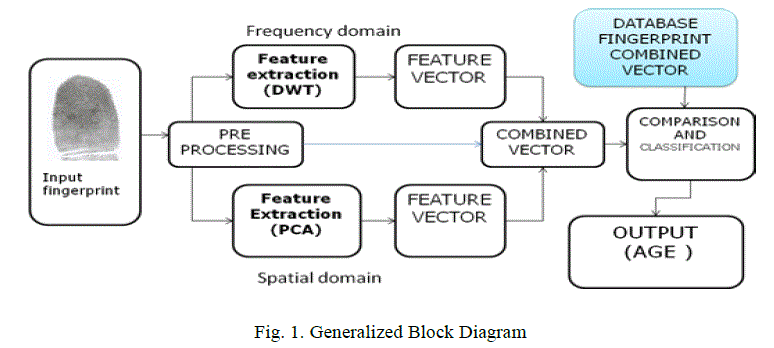 |
| Fingerprints are acquired real time and from the database sources. A fingerprint age estimating system
constitutes of digital images of fingerprint as its input which is then transformed. The algorithm can be developed using
MATLAB programming language. We use 2D- Discrete Wavelet Transform (DWT) and Principal Component
Analysis (PCA) combined to estimate a person’s age using his/her fingerprint. The obtained fingerprint goes through
preprocessing stage for enhancement and removing the noise. After preprocessing the fingerprint goes through two
levels of feature extraction, one is frequency domain feature vector obtaining by undergoing Wavelet decomposition
and second is by spatial level undergoing PCA. The next step is to combine the two vectors and this is compared with
the database for the minimum distance and classifies the fingerprint as to which class it lies. The rest of the paper is
organized as follows: literature survey is given in section II. Proposed system is discussed in section III. Age estimation
in section IV. Performance Analysis and future work in section V and VI. |
LITERATURE SURVEY |
| A . Overview of fingerprinting |
| Human fingerprints have been discovered on a large number of archeological artifacts and histological items.
Although these findings provide evidence to show that ancient people were aware of the individuality of fingerprints, it
was not until the late sixteenth century that the modern scientific fingerprint technique was first initiated (Jain, et al,
2003). In 1686, Marcello Malpighi, a professor of anatomy at the University of Bologna noted in his writings the
presence of ridges, spirals and loops in fingerprints. Henry Fauld, in 1880, was the first to scientifically suggest the
individuality of fingerprints based on an empirical observation. In the late nineteenth century, Sir Francis Galton
conducted an extensive study on fingerprints; he introduced the minutiae features for fingerprint matching in 1888. An
important advance in fingerprint recognition was made in 1899 by Edward Henry, who established the well-known
Henry system of fingerprint classification (Lee and Gaensslen, 2001). |
| The system was first used in India in 1858 by Sir William Herschel to prevent impersonation, but the credit is
given to Sir Francis Galton for having it systematized for the identification of criminals. His system was officially
adopted in England in 1894, and was further modified by Sir Edward Henry. Afterwards the studies have been
conducted on fingerprint ridges mainly its types, classification, methods of lifting fingerprints, recording of fingerprints
and materials used to develop fingerprint (Gungadin 2007). |
| B. Recent researches in Fingerprint Classification |
| Fingerprint identification and classification has been extensively researched in times past, however very few
researchers have studied the fingerprint gender classification problem, (Acree 1999) used the ridge density, which he
defined as the number of ridges in a certain space; it was shown that the females have higher ridge density
(Acree1999). (Kralik 2003) also showed that the males have higher ridge breadth,) which was defined as the distance
between the centers of two adjacent valleys), than females.Two studies showed that the males have higher ridge count
than the females (Hall, Timura 2003) and (Cote, Earls, Lalumiere 2002). It was shown that both males and females
have higher rightward directional asymmetry in the ridge count, with the asymmetry being higher in males than females
(Hall and Kimura 2003), and higher incidence of leftward asymmetry in females. (Cote et al 2002). Female's
fingerprints are significantly of lower quality than male fingerprints (Hicklin and Reedy. 2002). While the appearance
of white lines and scars in fingerprint images are very common in housewives (Wendt 1955). |
PROPOSED SYSTEM |
| The following paper aims in creating a system that is used to estimate the age from an obtained fingerprint.
Fingerprints are acquired real time and from the database sources. A fingerprint age estimating system constitutes of
digital images of fingerprint as its input which is then transformed. The algorithm can be developed using MATLAB
programming language. We use 2D- Discrete Wavelet Transform (DWT) and Principal Component Analysis (PCA)
combined to estimate a person’s age using his/her fingerprint. The obtained fingerprint goes through preprocessing
stage for enhancement and removing the noise. After preprocessing the fingerprint goes through two levels of feature
extraction, one is frequency domain feature vector obtaining by undergoing Wavelet decomposition and second is by
spatial level undergoing PCA. The next step is to combine the two vectors and this is compared with the database for
the minimum distance and classifies the fingerprint as to which class it lies |
| The database for our analysis is done on 547 individual fingerprints of male and female of different ages
between 12- 64. The database fingerprints goes through the process and the feature vectors are stored in the database
and is used for classification. |
| A. Preprocessing |
| Image enhancement processes consist of a collection of techniques that seek to improve the visual appearance
of an image or to convert the image to a form better suited for analysis by a human or a machine. Enhancements
techniques like contrast enhancement, histogram equalization, biniarization, thinning and inverting are used as per the
requirement of the image to be enhanced. The fingerprint is resized to 512x512. The fingerprint image obtained
undergoes image enhancement for improving quality of the ridges and valleys. The input image which is grayscale is
converted into binary. The output of preprocessing is shown in Fig 2. After preprocessing the fingerprints undergo
further processing. Enhancement methods changes from fingerprint to fingerprint and for different databases. Poor
quality fingerprints obtained can be enhanced for the betterment of the algorithms. |
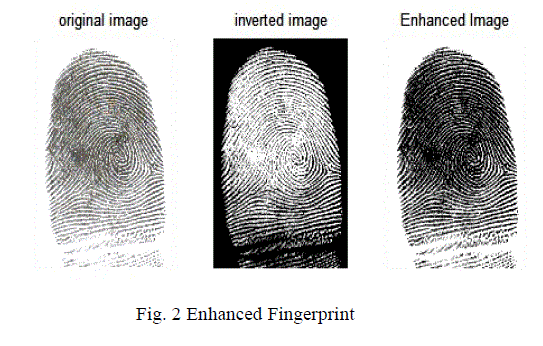 |
| B.DWT Feature Vector generation: |
| The fingerprint image undergoes discrete wavelet transformation for obtaining the feature vector. Wavelets
have been used frequently in image processing and used for feature extraction, denoising, compression, face
recognition, and image super-resolution. Two dimensional DWT decomposes an image into sub-bands that are
localized in frequency and orientation. The decomposition of images into different frequency ranges permits the
isolation of the frequency components introduced by “intrinsic deformations” or “extrinsic factors” into certain
subbands. This process results in isolating small changes in an image mainly in high frequency subband images. Hence,
discrete wavelet transform (DWT) is a suitable tool to be used for designing a classification system.The obtained image
is decomposed using the analysis filter bank and the low frequency and the high frequency bands are separated as
shown in the Fig. 3. |
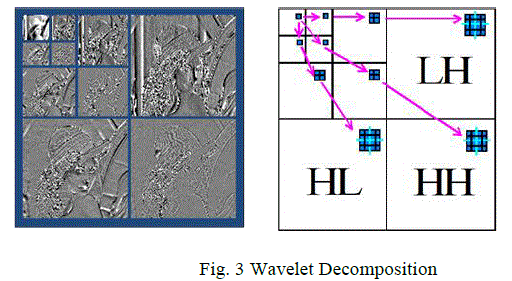 |
| The 2-D wavelet decomposition of an image is results in four decomposed sub-band images referred to as
low–low (LL), low–high (LH), high–low (HL), and high–high (HH). Each of these sub-bands represents different
image properties. Typically, most of the energy in images is in the low frequencies and hence decomposition is
generally repeated on the LL sub band only (dyadic decomposition). For k level DWT, there are (3*k) + 1 sub-bands
available. The energy of all the sub-band coefficients is used as feature vectors individually which is called as sub-band
energy vector (Ek). The energy of each sub-band is calculated by using the equation |
 |
| Each fingerprint undergoes six level decomposition after preprocessing as shown in Fig. 3. At each level we
get subbands and their energy is calculated. We get a total of 19 subbands and the energy vector Ek will be 1x19 vector
at the end of the six level decomposition for each fingerprint. All fingerprints in the database undergoes the
decomposition and the energy vector of all the images is stored. |
| C.PCA Feature Vector generation: |
| PCA algorithms are generally implemented for pattern recognition systems. Principal component
analysis involves a mathematical procedure that transforms a number of possibly correlated variables into a smaller
number of uncorrelated variables called principal components. The first principal component accounts for as much of
the variability in the data as possible, and each succeeding component accounts for as much of the remaining variability
as possible. It is also named as the Karhunen–Loeve transform which is also called as (KLT) the Hotelling transform. |
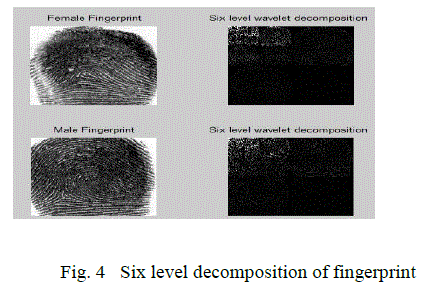 |
| PCA involves the calculation of the eigenvalue decomposition of a data covariance
matrixhttp://en.wikipedia.org/wiki/Covariance_matrix or singular value decomposition of a data matrix, usually after
mean centering the data for each attribute. The results of a PCA are usually discussed in terms of component scores and
loadings. PCA involves the calculation of the Eigen value decomposition of a data covariance
matrixhttp://en.wikipedia.org/wiki/Covariance_matrix or singular value decomposition of a data matrix, usually after
mean centering the data for each attribute. The results of a PCA are usually discussed in terms of component scores and
loadings.An eigen vector of a given linear transformation is a vector which is multiplied by a constant called the eigen
value as a result of that transformation. The direction of the eigenvector is either unchanged by that transformation (for
positive eigen values) or reversed (for negative eigen values).Every fingerprint in the database undergoes the PCA for
obtaining the eigenvector. The eigenvector is 512 x 1 size and is stored as another feature vector of the fingerprint. |
| D.Combined Feature Vector: |
| After undergoing DWT and PCA the feature vectors are stored separately. The next step is to combine both
the feature vector into a single vector which stores the frequency domain and spatial domain information of a
fingerprint. The 19 feature vector from the DWT and the 512 feature vector from PCA are combined to form 1 x 531
feature vector for a single fingerprint. Similarly for all the fingerprints in the database this procedure is followed and a
database feature vector is created which contains all the feature vector of the images in the database. If there are n
fingerprints in the database then the size of the database feature vector will be n x 531.A graph was plotted after
obtaining the combined feature vector. Till date spatial features where used for analysis and is well established. We
propose this system for the use of frequency domain analysis for the purpose. |
AGE ESTIMATION |
| All the fingerprints used for our algorithm was taken from the database of Department of Biometric research,
University of Ilorin. These fingerprints are optical scanned images. For Age estimation we divide the database into
different age groups like 15-20, 21-25, 26-30, 31-35, 36-40, 41-45, 46-50 and so on. The fingerprints of different age
group are grouped and kept as the database fingerprints.Once the desired database is formed all the fingerprints in it
undergoes the feature vector extraction as explained in the previous section. |
| Steps to be followed for Age estimation using the query fingerprint: |
| 1. The fingerprint undergoes pre processing and is resized to 512x512. |
| 2. The fingerprint undergoes Wavelet Decomposition and the 19 feature vector is obtained. |
| 3. The fingerprint from the pre processing stage also undergoes PCA Eigen vector feature extraction. This provides
the eigen vector of 512 size. |
| 4. Now the features vectors are combined in total 19+512 = 531 vectors are obtained from the fingerprint. |
| 5. This fingerprint feature vector is classified using the minimum distance classifier and this undergoes the Age
estimation classification. |
| A. Age estimation |
| The database fingerprints are grouped on the basis of the ages. Different age groups are formed for training
12- 20, 21-25, 26-30, 30-35, 36-40, 41-45, 46-50. For our experiment we have made seven groups and the fingerprints
of these ages are made to undergo the feature vector extraction steps. All the steps remain the same other than the
change in the groups in the database. The query fingerprint also undergoes the feature extraction and the feature vector
is obtained. The feature vectors of the query fingerprint are now ready for the Distance Measure which is established
for the classification process. After the extraction the classification is done by means of Distance measure. The
query vector is compared with all the seven classes and the class which forms the minimum distance with the given
fingerprint is taken for the age group of the Query Print. |
PERFORMANCE ANALYSIS |
| The algorithm was written in MATLAB 7.5 and was run on Intel Core 2 duo processor 1.66 GHz with 1 GB
memory. The process of feature vector extraction for the database is time consuming. We have used ¾th of the
database fingerprints for training and the rest was used for testing purpose. The result of the age estimation is shown in
Fig 5. |
| Results show us that frequency domain analysis of fingerprints can also be followed in future for the study of
dermatoglyphics. The overall success rate in age estimation is around 68% for our database. The graph of the success
rate is shown in Fig. 6. |
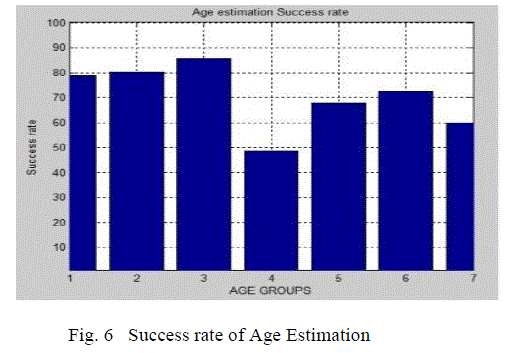 |
| The algorithm was implemented only on optical scanned prints. With optical scanned prints in database and
ink prints as query the algorithm was not much efficient because of the lack of training. It has been found that changing
the database also improves the estimation process. The number of database prints is an important criterion.
Experimental results show an overlap between the different age group fingerprints in some cases. Fingerprint size
depends on the growth of the human body. Persons of smaller age group with a body structure bigger than their normal
growth have fingerprints bigger than their group.The fingerprints of different age groups vary in size and patterns and
thickness of ridges and valleys. The fingerprints of people from various ethnic groups vary. An algorithm for
compressing the huge database of fingerprints has to be developed and the database of the feature vectors have to be
coded to provide a simpler database structure to reduce the complexity in calculations. |
FUTURE WORKS |
| The algorithm that was developed was simple which was to study how well frequency domain analysis help in
the classification. In future the algorithm has to be improved with a good classification algorithm like neural networks.
It has been found that improving the database is an important criterion for good classification and estimation. Ink
prints, optical scanned prints and prints from artifacts all can be used in the database. In future fingerprints from
different ethnic groups have to be collected for a large scale study. |
| An algorithm has to be developed for the compression of the fingerprints and its feature vectors. Databases
from different population groups have to be collected for storing the feature vector. Classification algorithms can be
developed that can be provided with the fingerprint feature vector for training. This will improve the strength of the
algorithm. More the number of fingerprints to be trained in each age group, the estimation of age from an obtained
fingerprint are to be precise. |
References |
- P. Gnanasivam& Dr. S. MuttanâÃâ¬ÃÅ Estimation of Age Through Fingerprints Using Wavelet Transform and Singular Value DecompositionâÃâ¬Ã International Journal of Biometrics and Bioinformatics (IJBB), Volume (6) : Issue (2) : pp 58-67. 2012
- RituKaur and SusmitaGhoshMazumdar âÃâ¬ÃÅFingerprint based gender identification using frequency domain analysisâÃâ¬Ã International Journal of Advances in Engineering & Technology, Vol. 3, Issue 1, pp. 295-299, March 2012
- Pankanti, S. Prabhakar, and A. K. Jain, âÃâ¬ÃÅOn the individuality of fingerprints,âÃâ¬Ã IEEE Trans. Pattern Anal. Mach. Intell.âÃâ¬ÃÂ, vol. 24, no. 8, pp. 1010âÃâ¬Ãâ1025, Aug. 2002.
- E.O. Omidiora, O. Ojo, N.A. Yekini, T.O. Tubi âÃâ¬ÃÅAnalysis, design and implementation of human fingerprint patterns system âÃâ¬ÃÅtowards age & gender determination, ridge thickness to valley thickness ratio (RTVTR) & ridge count on gender detectionâÃâ¬Ã International Journal of Advanced Research in Artificial Intelligence, Vol. 1, No. 2, pp 57- 63, 2012
- http://www.unilorin.edu.ng/step-b/biometrics
- D. Maltoni, D. Maio, A. K. Jain, and S. Prabhakar, âÃâ¬ÃÅHandbook of Fingerprint RecognitionâÃâ¬ÃÂ, first ed., Springer, New York, 2003.
- MiroslavKralik, Vladimir Novotny, âÃâ¬ÃÅEpidermal Ridge Breadth: An Indicator of Age and Sex in PaleodermatoglyphicsâÃâ¬ÃÂ, Variability and Evolution, Vol. 11, pp. 5-30, 2003.
- K. Thaiyalnayaki, S. A. Karim, P. V. Parmar, âÃâ¬ÃÅFinger print Recogntion Using Discrete Wavelet TransformâÃâ¬ÃÂ, International Journal of Computer Applications,pp.96-100,Vol.1,No.24, 2010
- A. K. Jain, S. Prabhakar and L. Hong, âÃâ¬ÃÅA multichannel approach to fingerprint classification,âÃâ¬Ã IEEE Transactions on PAMI, pp. 48359, Vol.21, No.4, Apr.1999.
- Manish Verma and SuneetaAgarwal, âÃâ¬ÃÅ Fingerprint Based Male-Female Classification.âÃâ¬Ãâ¢Ã¢Ãâ¬Ã⢠in Proceedings of the International Workshop On Computational Intelligence in Security for Information Systems (CISISâÃâ¬Ãâ¢08), Genoa, Italy, 2008, pp.251-257.
- D.Maio and D.Maltoni, âÃâ¬ÃÅRidge-line density estimation in digital images,âÃâ¬Ã in Proceedings of the 14th International Conference on Pattern Recognition (ICPR), 1998, pp. 534âÃâ¬Ãâ 538.
|